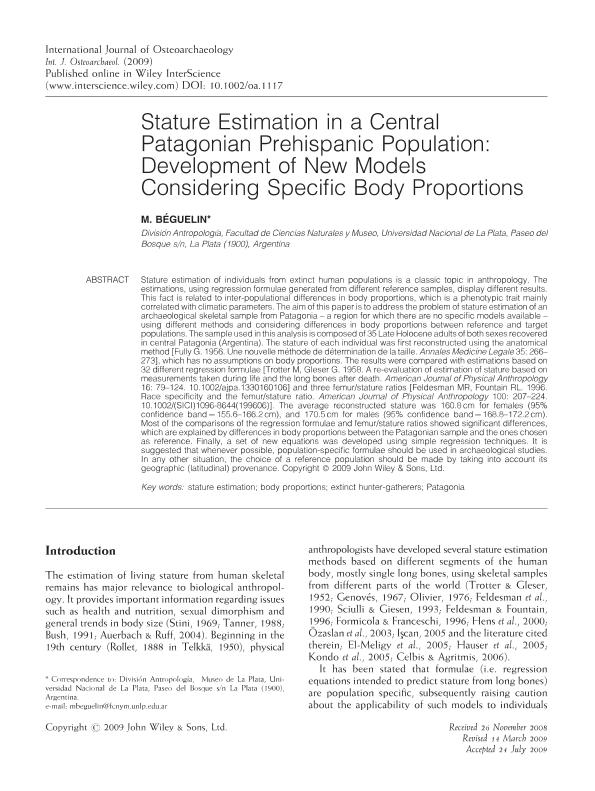Artículo
Stature estimation in a central Patagonian prehispanic population: Development of new models considering specific body proportions
Fecha de publicación:
03/2011
Editorial:
Wiley
Revista:
International Journal of Osteoarchaeology
ISSN:
1099-1212
e-ISSN:
1047-482X
Idioma:
Inglés
Tipo de recurso:
Artículo publicado
Clasificación temática:
Resumen
Stature estimation of individuals from extinct human populations is a classic topic in anthropology. The estimations, using regression formulae generated from different reference samples, display different results. This fact is related to inter-populational differences in body proportions, which is a phenotypic trait mainly correlated with climatic parameters. The aim of this paper is to address the problem of stature estimation of an archaeological skeletal sample from Patagonia - a region for which there are no specific models available - using different methods and considering differences in body proportions between reference and target populations. The sample used in this analysis is composed of 35 Late Holocene adults of both sexes recovered in central Patagonia (Argentina). The stature of each individual was first reconstructed using the anatomical method [Fully G. 1956. Une nouvelle me´thode de de´termination de la taille. Annales Medicine Legale 35: 266-273], which has no assumptions on body proportions. The results were compared with estimations based on 32 different regression formulae [Trotter M, Gleser G. 1958. A re-evaluation of estimation of stature based on measurements taken during life and the long bones after death. American Journal of Physical Anthropology 16: 79-124. 10.1002/ajpa.1330160106] and three femur/stature ratios [Feldesman MR, Fountain RL. 1996. Race specificity and the femur/stature ratio. American Journal of Physical Anthropology 100: 207-224. 10.1002/(SICI)1096-8644(199606)]. The average reconstructed stature was 160.8 cm for females (95% confidence band = 155.6-166.2 cm), and 170.5 cm for males (95% confidence band = 168.8-172.2 cm). Most of the comparisons of the regression formulae and femur/stature ratios showed significant differences, which are explained by differences in body proportions between the Patagonian sample and the ones chosen as reference. Finally, a set of new equations was developed using simple regression techniques. It is suggested that whenever possible, population-specific formulae should be used in archaeological studies. In any other situation, the choice of a reference population should be made by taking into account its geographic (latitudinal) provenance.
Palabras clave:
stature estimation
,
body proportions
,
extinct hunter-gatherers
,
Patagonia
Archivos asociados
Licencia
Identificadores
Colecciones
Articulos(CCT - LA PLATA)
Articulos de CTRO.CIENTIFICO TECNOL.CONICET - LA PLATA
Articulos de CTRO.CIENTIFICO TECNOL.CONICET - LA PLATA
Citación
Beguelin, Marien; Stature estimation in a central Patagonian prehispanic population: Development of new models considering specific body proportions; Wiley; International Journal of Osteoarchaeology; 21; 2; 3-2011; 150-158
Compartir
Altmétricas




